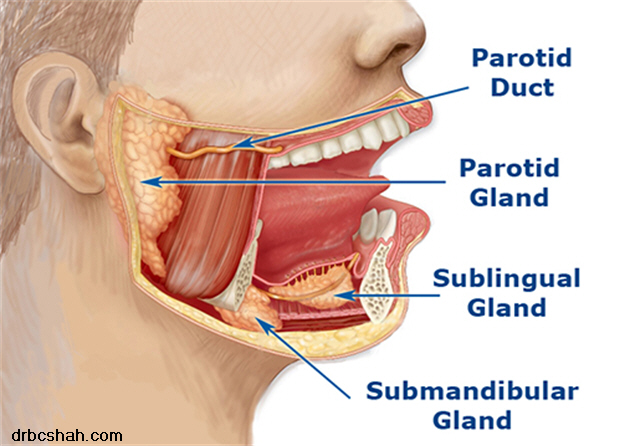Salivary Gland Tumor Removal
A parotidectomy is a surgery to remove a portion or entirety of the parotid gland.
Hundreds of surgeries, called parotidectomies, are performed each year to remove benign (non-cancerous) or cancerous parotid tumors. These tumors can develop in the various cells of the salivary glands when the body’s normal regulating mechanisms are not functioning correctly.
WHAT ARE SALIVARY GLANDS AND SALIVARY GLAND TUMORS?
The salivary glands secrete saliva into the mouth to assist in digesting foods. Humans have 3 pairs of major salivary glands: 1) parotid glands, 2) submandibular glands, and 3) sublingual glands. The parotid glands are the largest salivary glands and are located in front of the ear in the cheek area and slightly over the jaw line. The smaller submandibular glands are located under the jaw and the sublingual glands, the smallest major salivary glands, are located under the tongue. Hundreds of minor salivary glands, each about the size of a grain of sand, exist and line the mucous membranes inside the mouth.
Salivary gland tumors can be either benign (non-cancerous) or malignant (cancerous). Most parotid tumors are benign but there is still a 20% chance that a parotid mass may be malignant. The most common type of parotid tumor is a Pleomorphic Adenoma, also called a benign mixed tumor.
SYMPTOMS OF SALIVARY GLAND TUMORS
- A “lump” in the cheek or neck
- Benign masses are usually painless
- Weakness of facial muscles on the side of tumor location may indicate a malignant process
TREATMENT FOR SALIVARY GLAND TUMORS
Surgical excision is the treatment of choice for nearly all salivary gland tumors – benign or malignant, unless the physical condition of the patient prohibits surgery. This may be the case in some situations involving benign (non-cancerous) tumors. Without surgical removal, the tumors continue to grow and cause cosmetic and functional problems. In certain cases, like the pleomorphic adenoma, there is a risk that the benign tumor will degenerate over time into a malignancy (cancer). A parotidectomy involves removing salivary tissue containing the tumor from the surrounding tissue bed while sparing the facial nerve that controls facial movement. This nerve passes through the parotid gland and makes this surgery more intricate and demanding. Dr. Gunnlaugsson has extensive experience in performing parotidectomy surgery. Dr. Gunnlaugsson is also certified by the American Board of Facial Plastic and Reconstructive Surgery and places an emphasis on cosmetic incision placement and appearance following the procedure.


 Dr. Bimal Shah is the senior most General & Laparoscopic surgeon in Mira – Bhayandar with largest series of operations. He also consults at Borivali – Dahisar. He believes in ethical practice & is available at only trust hospitals. He passed out from KEM hospital, Mumbai in 1993 and was a lecturer training newer surgeons & medical students till 1998.
Dr. Bimal Shah is the senior most General & Laparoscopic surgeon in Mira – Bhayandar with largest series of operations. He also consults at Borivali – Dahisar. He believes in ethical practice & is available at only trust hospitals. He passed out from KEM hospital, Mumbai in 1993 and was a lecturer training newer surgeons & medical students till 1998. 






